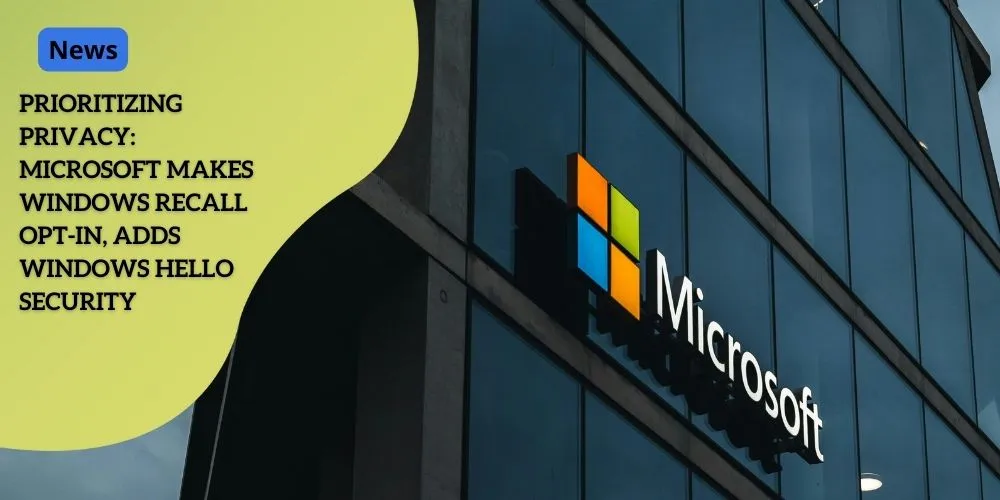Prioritizing Privacy: Microsoft Makes Windows Recall Opt-In, Adds Windows Hello Security

Anúncios
Microsoft’s Initial Recall Feature Faced Backlash
Introducing the Recall Feature
Last month, Microsoft introduced a cutting-edge AI-powered feature called Recall for its Copilot+ PCs. The design aimed to revolutionize how users access past data by maintaining a detailed history of their activities. This seemed like a forward-thinking innovation at first glance, promising enhanced productivity and convenience.
Privacy and Security Concerns
However, the initial excitement quickly gave way to significant pushback from customers. The crux of the controversy? The Recall feature collected screenshots and user data for up to three months at a time without seeking explicit consent from users. This led to widespread concern about potential privacy violations and data security risks.
Anúncios
Details of the Issue
- Data collected included screenshots and activity records.
- This data was stored for a period of three months.
- There was no opt-in or explicit consent required, raising serious privacy concerns.
Customer Backlash
The revelation of these practices didn’t sit well with users. They expressed concern that such extensive data collection could be misused or fall into the wrong hands. Security experts also weighed in, highlighting the potential vulnerabilities in the system. As a result, Microsoft faced a barrage of criticism from both everyday users and corporate clients alike.
An anonymous user remarked, “The idea of every move I make being recorded without my knowledge is quite unsettling.” This sentiment echoed across social media platforms and tech forums, putting Microsoft in a tough spot.
Anúncios
Key Issues Raised
- Lack of explicit user consent.
- Potential misuse of collected data.
- Vulnerabilities in data encryption exposing users to malware attacks.
Microsoft’s Response
Recognizing the gravity of the situation, Microsoft was quick to acknowledge the oversight. In their commitment to prioritizing user privacy and security, the company announced significant updates to the Recall feature. These updates include requiring users to opt-in and verify their presence through Windows Hello, an advanced biometric authentication system.
The search index database now also has an additional decryption layer for enhanced security, ensuring that data remains protected even in the event of malware attacks.
As the rollout date approaches on June 18 for Copilot+ PCs with Snapdragon X ARM processors, Microsoft continues to work on extending Recall compatibility to Intel and AMD CPUs as well.
These changes showcase Microsoft’s broader commitment to security, as emphasized by CEO Satya Nadella, and aim to rebuild user trust.
Microsoft’s Response: Prioritizing Privacy and Security
Opt-In Feature for Enhanced User Control
Microsoft stepped up to the plate following the backlash over the initial launch of its Recall feature. Citing privacy and security concerns, many users were uncomfortable with the way Recall silently collected screenshots and user data for up to three months. In response, Microsoft announced that it will update Recall to require customers to opt-in, giving them explicit control over the feature’s activation. As Pavan Davuluri, Corporate Vice President of Windows & Devices, emphasized, “If you don’t proactively choose to turn it on, it will be off by default” .
Windows Hello Authentication: Proving User Presence
Further addressing privacy concerns, Microsoft integrated Windows Hello as a prerequisite for using Recall. This ensures that users must prove their presence via biometric authentication before they can enable or access Recall. Windows Hello, which uses facial recognition or fingerprint scanning, adds an additional layer of security by making sure that only the enrolled user can unlock the data.
Enhanced Security Measures through Windows Hello ESS
Microsoft has fortified the Recall feature with an added layer of security called Windows Hello Enhanced Sign-in Security (ESS). The search index database, where Recall stores its data, is protected by an additional decryption layer. This means that the data will only be decrypted and accessible when the user successfully authenticates through Windows Hello.
- Recall data remains encrypted until a user authenticates with Windows Hello.
- Windows Hello ESS requires biometric enrollment before Recall can collect data.
These measures ensure that even if malware gains access to a user’s device, it cannot decrypt the Recall data without Windows Hello authentication.
Reflecting Microsoft’s Commitment to Privacy and Security
CEO Satya Nadella emphasized Microsoft’s commitment: “If you’re faced with the tradeoff between security and another priority, your answer is clear: Do security”. Microsoft’s swift reaction to the backlash demonstrates its serious focus on securing user data and restoring customer trust.
Looking Forward: Rollout and Future Plans
The updated preview version of Recall with these enhanced security features will roll out on June 18 for Copilot+ PCs with Snapdragon X ARM processors. There are also plans to expand Recall’s compatibility to Intel and AMD CPUs in the future, ensuring that more users across different platforms can benefit from its functionalities without compromising on security. By prioritizing user consent and bolstering security measures, Microsoft aims to address initial concerns and provide a safer, more trustworthy experience for its users. “`
Enhanced Security Measures for Recall
Microsoft’s commitment to strengthening the security of its AI-powered Recall feature has culminated in a series of meticulously devised enhancements. These updates are designed to ensure that user data remains protected and encryption mechanisms robust to thwart potential security threats. Here’s a breakdown of the key measures that have transformed Recall into a more secure feature for Copilot+ PCs.
Windows Hello Authentication
One of the primary security improvements involves Windows Hello authentication. To use Recall, users must verify their presence using Windows Hello. This authentication step ensures that only the legitimate user has access to the decrypted data stored in the Recall feature. By requiring this biometric proof, Microsoft adds a critical layer of security to shield user data from unauthorized access.
Biometric Enrollment Requirement
Before Recall can start collecting any data or be launched, users must enroll their biometrics with Windows Hello. This preemptive step is crucial for safeguarding privacy even before the use of Recall. Enrolling biometrics ensures that any data collected or indexed by Recall is always tethered to secure user identification protocols, significantly reducing the risk of breach or misuse.
Enhanced Decryption Layers
Another significant update is the additional layer of decryption protection for the search index database through Windows Hello Enhanced Sign-in Security (ESS). Previously, databases were encrypted by Bitlocker, which was not fully effective against sophisticated malware that could access the database post-login. Now, Recall data will remain encrypted until a user authenticates with Windows Hello each time they open the app. This change mitigates the risk of malware accessing sensitive data post-login, enhancing the overall security of the database.
Consistency with Microsoft’s Security Vision
These security enhancements align strongly with Microsoft’s broader vision of prioritizing security. As emphasized by CEO Satya Nadella in a recent communication, the company’s stance is clear: “If you’re faced with the tradeoff between security and another priority, your answer is clear: Do security. This is key to advancing both our platform quality and capability.”
By updating Recall to ensure user opt-in, mandatory biometric verification, and an added encryption layer, Microsoft is taking deliberate steps to rebuild user trust and safeguard their information. These updates reflect a deep-seated commitment to enhancing security across its ecosystem, with the upcoming Recall preview set to debut on June 18 for Copilot+ PCs featuring Snapdragon X ARM processors, and plans to expand compatibility to Intel and AMD CPUs in the future.
For further details, check out the official announcement on Microsoft’s recent security enhancements to Recall on.
“`
Rollout and Future Plans for Recall
Official Debut of Enhanced Recall
June 18 marks a pivotal day for Microsoft as they roll out the updated Recall (preview) for Copilot+ PCs equipped with Snapdragon X ARM processors. This rollout isn’t just about introducing new features; it’s about reestablishing trust with users who voiced significant concerns about privacy and security. The robust security measures emphasized in prior chapters ensure that the initial backlash is addressed effectively.
Mandatory Opt-In Process
One key change is the requirement for users to actively opt-in to enable Recall, acknowledging the need for more control over personal data usage. The opt-in process is designed to be straightforward yet thorough, giving users peace of mind.
- Users must opt-in to activate Recall, ensuring that no data is collected without explicit consent.
- Windows Hello verification is mandatory, adding a biometric layer of security before the feature is accessible.
Windows Hello Enhanced Sign-in Security (ESS)
The enhanced security doesn’t stop at opt-in. Microsoft’s Windows Hello Enhanced Sign-in Security (ESS) adds an additional decryption layer to the search index database. This ensures that the Recall data remains encrypted and inaccessible to potential threats unless the user authenticates through Windows Hello.
Future Plans and Expansion
Microsoft’s future plans are just as ambitious as their immediate fixes. While the enhanced Recall now debuts on Snapdragon X ARM processors, there are concrete plans to extend compatibility to Intel and AMD CPUs.
- June 18: Initial debut on Copilot+ PCs with Snapdragon X ARM processors.
- Future rollout: Expansion to Intel and AMD CPU platforms, ensuring broader availability.
Commitment to User Trust and Security
These steps are in line with CEO Satya Nadella’s words stressing the importance of prioritizing security. By making these updates, Microsoft aims to advance both platform quality and user trust. The move is consistent with their vision to protect the digital estates of their customers, eventually creating a safer world for all.
Conclusion
Microsoft’s proactive approach in addressing privacy concerns is evident in this well-planned rollout. With the initial updates set for June 18 and further expansions on the horizon, users can expect a more secure and trustworthy experience.






